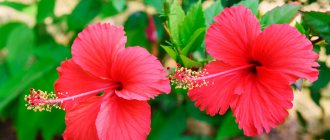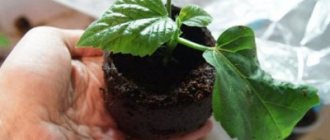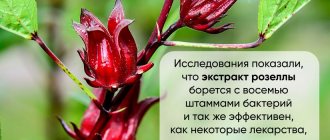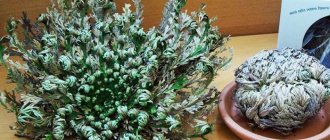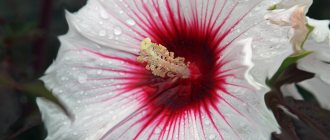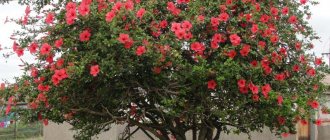How to grow Sudanese rose at home
To get this flower, you need to purchase cuttings or seedlings. Unfortunately, such planting material is quite scarce and rarely found. Most often, cuttings are prepared independently. It is very problematic to grow Sudanese rose in any other way. Let's look at how this is done step by step:
- We buy soil (for shrubs) or prepare a mixture of peat, compost, sand, and manure. It should be very airy, light with good air exchange.
- We prepare several containers of different sizes. If this is not possible, then the plant is immediately planted in a large pot, but as it develops and grows, weighted soil is added.
- The seeds are pre-soaked in water at room temperature and must be pickled with a weak solution of potassium permanganate.
- Prepare growth accelerators. You can use Epin-extra. It has a beneficial effect on the rooting of cuttings. It is also suitable for soaking seeds.
Keep in mind that this is a very tender heat-loving plant that does not tolerate drafts. He needs to create, at least during the growth stage, greenhouse conditions in the literal sense. After all, even the temperature regime is very strict. Sprouts are grown at a temperature of 19-21 degrees. If these conditions are not met, the plant will be weak and painful. If dry tips and edges of the leaves are found, they must be periodically sprayed with warm water. If this is observed on an adult shrub, then pruning is performed, followed by processing of the branches.
Growing Sudanese rose at home
Those who love home plants, as well as a pleasant and healthy drink and natural cosmetics, can grow this wonderful flower at home. In garden nurseries and garden supply stores, you are unlikely to find rooted cuttings or young hibiscus seedlings. Therefore, you will have to start growing Sudanese roses yourself. Subsequently, it will be possible to harvest cuttings from your lignified plant, rooting them in the usual way, i.e. soaking in a growth stimulant and planting in soil or sand under a glass jar.
Seeds can be ordered on the Internet or, even easier, look for them in a purchased bag of hibiscus. Soak them, and after a tender sprout appears, plant them in a small pot, which, as the plant grows, will need to be replaced with a larger container (a tub with a capacity of up to 100 liters). The soil for the young shoot needs to be prepared lightly. The easiest way is to buy a package of ready-made soil substrate for ornamental shrubs, which includes leaf and raised soil, peat, sand and humus. As the plant becomes heavier and grows (up to two meters in height), it is transplanted into a pot with heavier soil, and if the volume of the pot allows, and there is no way to replant the flower, then simply add new soil.
Features of planting and caring for hibiscus
Growing in an apartment
The plant prefers flowerpots based on the size of the root system. In cramped spaces it will develop poorly and look depressed, and in too spacious spaces the roots may rot.
To grow Sudanese roses at home, you need to prepare a nutritious soil mixture from equal parts of leaf and turf soil, rotted humus and river sand.
Before planting the plant in the prepared soil mixture, it must be calcined in the oven for 30-45 minutes. This will destroy most pests and pathogenic bacteria. Such treatment will not affect the quality of the soil.
Coarse river sand or medium-fraction expanded clay can be used as drainage. The drainage layer must be at least 4 cm.
Tip: if you don’t have commercial drainage at hand, you can put crushed stone washed and calcined in the oven at the bottom of the flowerpot.
In the first two to three years, the Sudanese rose needs annual replanting, then replanted every two or three years. For adult specimens that are more than 8-10 years old, only the top layer of soil is replaced by 5 cm.
Regularly pinch the tops of young shoots. This promotes better branching of the bush and the formation of flower buds, which form only on the shoots of the current year.
Hibiscus feels equally good both in bright sun and in partial shade. However, a lack of sunlight can negatively affect its flowering.
During the midday hours, the plant should be shaded.
Water the Sudanese rose after the top layer of soil has dried. Water for irrigation should be settled and warm. In summer, water abundantly, in winter - moderately.
For abundant flowering, the Sudanese rose is fed with fertilizers for flowering plants or special ones intended for hibiscus.
Sudanese rose or hibiscus:
In the open ground
Sudanese rose can be grown in a flower bed as an annual. Rooted cuttings are planted in open ground in spring or early summer, when the air temperature at night does not drop below +15°C.
Planting material is prepared in advance: in July-August, during scheduled pruning.
To do this, cut cuttings with four to five internodes using a sharp knife or pruning shears and soak for 1 hour in a solution of any root formation stimulator.
After this, they are planted in plastic cups filled with light soil with the addition of perlite or vermiculite, moistened and placed under a plastic bag.
After this, without washing off the juice, plant it in the prepared soil mixture.
In a month, the regrown roots will be visible through the transparent walls of the glasses. After this, the cuttings are transplanted into small pots and cared for as described above.
The plant in the flowerbed quickly turns into a beautiful bush, strewn with bright flowers. It is undemanding to watering, can withstand direct sunlight, and is content with one or two feedings.
In open ground, this plant will bloom until cool weather arrives.
After this, it can be transplanted into a flowerpot and moved indoors for the winter. With the arrival of spring, the shoots are shortened and the plant is planted in a flower bed.
Peculiarities of hibiscus reproduction
Many indoor plant lovers grow this wonderful and useful flower at home. For self-cultivation, propagation is used. Cultivation is carried out in two ways - propagation by seeds and cuttings.
Growing from seeds
It is believed that growing such a rose from seeds is much easier.
Firstly, this method is less labor-intensive, and secondly, the flower seeds have good germination even after 5 years. The seeds are bought in a special store, but you can also get them from packaged Hibiscus tea. Planting seeds in greenhouses or pots is carried out as follows:
- Before planting, you need to disinfect the planting material. To do this, the seeds are soaked for 30–60 minutes in a weak solution of potassium permanganate.
- After the time has passed, the seeds should be washed well in running water. Next, for germination, they are soaked in a growth stimulator (planting material is placed in a cloth soaked in the solution).
- After 3–4 weeks, young sprouts will appear; seeds with sprouts are sown in prepared separate pots. If the seedlings will be planted in a greenhouse or soil, then it is better to sow in a disposable container.
Rose is quite picky about the composition of the soil . For it, it is better to choose a special soil mixture that has good drainage properties and is also fertile. The best option is to buy ready-made soil . But you can also prepare the soil mixture yourself. Sand is taken as the basis and humus, peat, and high soil are added to it. It is recommended to add wood ash as fertilizer.
Planting by cuttings
Growing Sudanese roses from cuttings helps preserve the decorative features of the flower. Growing a flower using this method is not difficult; you just need to follow some agrotechnical rules, which include the following points:
- Cuttings should be used only from young (one-year-old) shoots. It is allowed to use the upper shoots that remain after pruning.
- The best period for rooting is spring or the second decade of summer. It is important that the shoots have time to take root before the first cold weather.
- If cuttings are harvested directly from the bush, then the lower cut should be 0.5–1 cm below the bud.
- The best cutting length is considered to be 10–15 cm. 3–4 viable buds should grow on it.
- 24 hours before planting, the cuttings are lowered with their lower parts into a stimulating solution for root growth.
- Next, the cuttings are planted in a moist soil mixture, which consists of peat and sand with the addition of humus and leaf soil.
- To create a greenhouse effect, the planted planting material is covered with a transparent plastic bottle.
Video: Growing sturgeon at home (Azerbaijan)
From annual apical shoots, cuttings measuring 10 cm are cut, making sure that each cutting has 3-4 buds. The top cut should be located at a distance of approximately 5 mm from the kidney. The prepared cuttings are planted in a container with soil to a depth of 3 cm and covered with plastic film to create increased air humidity.
The soil for rooting cuttings and further planting should be nutritious and light. The best option is a mixture of the following ingredients: turf and leaf soil, humus (necessarily rotted), peat and sand in a ratio of 5:1:1:1. Before filling the pot with soil mixture, drainage in the form of river pebbles is placed at the bottom.
For normal development and flowering, the Sudanese rose requires special care, which consists of the following:
– the temperature regime is maintained within +19...+23 degrees in spring and summer, with a slow decrease to +17...+18 degrees in autumn. In winter, the plant can be kept at a temperature not lower than +16 degrees. Sudden temperature changes can cause leaves and buds to fall off. Sudanese rose loves fresh air, so the room should be ventilated often;
– the necessary air humidity should be maintained by spraying the plant with slightly lukewarm, soft water. The Sudanese rose most needs this procedure during the release of buds and flowering;
– the lighting must be bright, but the plant must be shaded from direct sunlight. In winter, the Sudanese rose receives additional lighting for 8-10 hours;
– water the Sudanese rose quite abundantly during the growing season, making sure that the roots do not rot. The plant is quite capricious and may begin to drop buds if the soil dries out slightly;
– fertilizing is carried out monthly in the spring and summer with the help of special complex fertilizers intended for flowering indoor plants, and always after watering your exotic plants.
Growing at home
Despite the unpretentiousness of the Sudanese rose, not all gardeners have the opportunity to enjoy its colorful blooms at home. The fact is that in order to grow this flower, certain conditions must be created. But this problem is completely solvable.
The main condition for the rapid growth and flowering of hibiscus is regular watering. Under no circumstances should the earthen ball be allowed to dry out, as the plant may shed its leaves. You especially need to be careful in the summer, since the plant needs frequent watering in the heat.
The air humidity in the room is also of great importance. Hibiscus loves high humidity, and therefore the leaves and air around the bush should be regularly sprayed with settled water.
Experienced gardeners recommend growing Sudanese rose on a light windowsill, as it is very light-loving. Without bright sunny color, the shrub simply will not bloom. Moreover, it is necessary to ensure good illumination in winter, by illuminating the plant with lamps.
In the wild, hibiscus grows in warm regions, so the room temperature should be maintained at least +24 degrees. In winter, the temperature can drop to +12. At lower temperatures, the Sudanese rose may die.
When planting a plant, you should take into account its soil preferences. Rose loves nutritious soil with a neutral reaction environment.
You can also grow hibiscus in a soil mixture that is independently composed of:
- 4 parts leaf soil;
- 3 parts of turf;
- 1 part humus;
- 1 part sand.
It is useful to add a little ash and peat to the soil mixture to make the soil more saturated.
The pot must have good drainage. Under conditions of heavy watering, there is a danger of root rotting, so water should not be allowed to stagnate in the pot.
Disembarkation
Before you grow a rose from a bouquet, you need to think about where exactly it will “live” in the future. There are two options - in the house or on the street. In the second case, you need to be aware that in our country, in most regions, winters are very harsh. And sometimes even autumn is not happy with the weather, and summer is not going well. All this can lead to the bush dying without even having time to take root in a new place.
However, there is good news for enthusiasts. Roses are grown outdoors even in regions with the most unfavorable conditions. It just takes a little more effort.
Typically, bushes are planted in open ground in late spring, in a well-lit and warm place, where they delight everyone until the first frost. Then the bushes are dug up, trimmed and placed in a pot for wintering. Some varieties can be left in the ground for the winter. But they are first carefully wrapped in straw, fallen leaves or a thick layer of sawdust.
If the plant is planned as a home plant, then it also needs to be replanted in the spring. But since the indoor microclimate is more favorable, you can plant bushes in a new pot not only in May, but also in March-April. The technology is the same as when planting cuttings.
Where did this strange drink come from?
Rosella or Hibiscus is an annual plant of the mallow family native to India. This is a grass, very beautiful and edible. There are varieties in the form of bushes and even trees. A famous drink is prepared from the purple flower petals and their calyxes.
Hibiscus tea is a traditional drink of the Egyptians. Even the pharaohs enjoyed it! It is extremely popular in hot tropical countries for its pleasant taste and excellent ability to quench thirst. Today, Sudanese rose flowers and petals, from which tea is made, are produced in India, Sudan, Mexico, China, Thailand, Java and Sri Lanka.
Sudanese rose: basic information
Sudanese rose: basic information
The Sudanese rose is known mainly under the name "Hibiscus" (or Chinese rose). Hibiscus bushes are often found in warm countries (Cyprus, Greece, Spain, Italy, Bulgaria, Turkey, etc.), and on vacation, seeing these beautiful large flowers, one involuntarily remembers from Soviet times pots with Chinese roses in schools, hospitals or on the windowsill by Grandma.
In fact, the Sudanese rose belongs to the Hibiscus genus, Mallow family. Hibiscus tea is produced from some varieties of Sudanese rose. But growing this crop is not very easy.
If only as a house plant, the Chinese rose or Chinese hibiscus grows well on the south side of the house. But we are not talking about any tea here; hibiscus is made from a different variety.
The Sudanese rose has exceptionally dark purple flowers and a greenish reddish stem. The average height of the crop is 5 m. Places of growth: Sudan, Mexico, Thailand, India, China, Java, Sri Lanka.
Interestingly, the coat of arms of Malaysia adorns the flower of the Sudanese rose, and Muslim believers see its petals as a reminder of the five commandments of Islam.
Methods for propagating self-rooted roses
The most common and simplest method of propagating this type of rose bushes is planting with green cuttings. Rooting shoots this way is very simple. This does not require specific skills. The main thing is to know the nuances of such a landing.
It is best to choose varieties that are characterized by rapid rooting rates.
- Large-flowered and small-flowered varieties of climbing, semi-climbing and miniature varieties.
- Medium-rooting remontant, floribunda, tea hybrids.
It is recommended to choose spacious areas for planting rooted bushes, as they grow very quickly.
Additional Information! Roses prefer to grow in open areas, on hills. It is also not advisable for water to accumulate in the rose garden in the spring.
Cuttings of self-rooted roses are best done in early spring in April, immediately after the snow has melted and the soil has begun to warm up.
What cuttings should look like
Preparatory stage of planting cuttings:
- Annual shoots are suitable for planting.
- They are cut into lengths of 20-25 cm.
- All buds and lower leaves must be torn off immediately.
- Then the cuttings are placed in a solution of potassium permanganate. For greater effect, it is recommended to place them in a growth activator, for example, Kornevin or Epin, for several hours.
- After this, the lower side of the cutting is cut at an acute angle and left on the windowsill so that the branch dries from water.
- The last stage is planting in the ground. You can use a universal soil mixture. During planting, cuttings are buried so that 2-3 buds remain in the ground, and the other 3 on the surface.
The cuttings can be planted in a peat pot and immediately planted in open ground. In this case, the above-ground part is covered with a glass jar so that the root formation process takes place as actively as possible.
Planting cuttings
During the rooting process, it is necessary to monitor the humidity level. If there are droplets of water in the jar, then the humidity level is normal. If there are none, you need to remove the jar, spray it inside and water the cutting. Several times a week, the jar needs to be raised for 10 minutes to allow the soil to breathe.
After a few weeks, leaves will begin to appear on the cutting, but the jar must not be removed until the young shoot is placed inside the jar. Also at this time they begin to harden the rose. In the evenings, the jars are removed, and every day the time the rose stays in the open air increases.
Important! If rooting was carried out in the fall, then the jars are left for the winter and be sure to cover them with bastweed. After rooting is complete, the roses can be planted in a permanent place
To do this, you need to dig holes, fill the bottom with drainage mixed with soil and plant a bush. After planting, be sure to water the bushes generously with warm water.
After rooting is completed, the roses can be planted in a permanent place. To do this, you need to dig holes, fill the bottom with drainage mixed with soil and plant a bush. After planting, be sure to water the bushes generously with warm water.
How to care?
Hibiscus Sudanese rose is considered one of the most unpretentious houseplants to care for. Growing it does not require any special effort, but it is necessary to follow certain rules. Only in this case will rosella delight you with shiny bright leaves and large flowers.
Landing. A plant purchased in a store, or grown from cuttings or seeds, is planted in a specially prepared earthen mixture. You can buy it ready-made, but experienced gardeners prefer to prepare the soil themselves. For the earth mixture you will need leaf and turf soil, peat, sand. A drainage layer of river pebbles or small stones is placed on the bottom of a spacious dish.
The plant is planted without deep deepening and watered abundantly after planting.
- The soil for Sudanese roses must, first of all, be nutritious. In addition to the specified composition of the earth mixture, a mixture is also used, consisting of one part of turf and leaf soil, half of a part of humus earth with the addition of a small amount of sand. Peat is added only for young plants. It is necessary to take the same amount as turf or leaf soil was taken. Drainage can be made not only from stones, but also from expanded clay, pieces of red brick or clay shards.
- Transplanting Sudanese hibiscus requires special attention. First of all, this concerns the root system. The plant is replanted using the transshipment method so as not to damage the roots. The best time of year for replanting is spring. The containers are selected so that the diameter of the new pot is two or three centimeters larger than the diameter of the previous one. Preliminary preparation of the plant for transplantation involves cutting the branches to about a third of their current length.
The frequency of transplanting young hibiscus under five years of age is once a year. Mature plants from five years old are replanted no more than once every three or four years.A Sudanese rose growing in a large tub does not need to be replanted, limiting itself to changing the top layer of soil.
- Watering Sudanese hibiscus is carried out in a mode strictly corresponding to the current time of year. The plant loves moisture, so in summer the soil is kept constantly moist. In winter the situation changes. Watering becomes moderate, without waterlogging or excessive drying out of the soil. The water temperature for irrigation should not be too low.
Frequent drying out leads to hibiscus dropping buds.
Like many moisture-loving plants, the Sudanese rose needs not only proper watering, but also regular spraying. In winter, due to the functioning of the central heating, the humidity can be increased using humidifiers. In summer, or at high air temperatures in winter, the plant must be sprayed generously and often.
Regular spraying protects the plant from aphids!
- Fertilizers are applied regularly after abundant watering. The plant is fed every week using organic and mineral fertilizers. To increase the intensity of flowering, phosphate-containing compounds are suitable. The rest period involves feeding no more than once a month.
- It is best to place rosella on a light windowsill, as the plant loves bright light. In winter it is necessary to organize additional lighting.
- The air temperature in the room where the Sudanese hibiscus is located should be within 25 degrees in the summer, subject to frequent ventilation, and not lower than 12 degrees in the winter.
In order for the Sudanese rose to live its usual period of twenty or more years, in addition to a special watering regime and regular fertilizing, pinching and pruning must be performed. Pruning is carried out every year and stimulates abundant flowering. The reason is that flowers appear only on young shoots. Pinching and pruning not only form the desired shape of the bush, but also cause active growth of young shoots, on which flowers will subsequently bloom.
The cut area must be treated with garden varnish.
In order to enjoy large flowers, up to 16 cm in diameter, it is worth parting with old and diseased shoots. Hibiscus blooms mainly in summer. But, if desired, the flowering period can be shifted, providing the plant with an unscheduled period of rest and reducing the intensity of watering. The reward will be exotic flowers of various shades. The flowers, mostly odorless, although some varieties have a pleasant aroma, bloom in the early morning and fade after sunset. The short duration of flowering is compensated by a large number of blooming buds.
Caring for Sudanese rose
Transfer
As the hibiscus grows, it needs to be transplanted into a larger container. It is best to do this in the spring, choosing a pot for the new residence that is 2-3 cm larger than the old one. The transplant procedure requires caution. It is preferable to place the plant in another flower container together with an old clod of earth, so as not to damage the root system. This transfer is called transshipment. In front of it, the hibiscus can shorten the branches by approximately 1/3.
Sudanese rose develops quickly, so a young plant must be replanted annually during the first five years of its life, and an adult rosella once every four years. Some varieties of Sudanese hibiscus (except dwarf ones) grow up to 1.5-2 meters at home, so replanting adult plants is quite difficult. In this case, in a tub or large flowerpot it will be enough to replace the top layer of soil.
Watering
The intensity of watering depends on the time of year and the “climate” of the apartment or house. In summer, rosella loves soil that is constantly moist. In winter, the frequency of watering is reduced, but care is taken to ensure that the soil does not dry out too much. Lack of moisture causes the buds to drop, and you may not see the magnificent blooms for which hibiscus is famous. In addition, water intended for irrigation must be settled and warm. Sudanese rose is moisture-loving, so in addition to watering, it must be constantly sprayed, especially in the summer heat and winter, when the indoor air is dry. In addition, regularly moistening the leaves will protect the plant from aphids and other pests. During flowering, spraying is done so that water does not fall on the flowers.
Top dressing
Hibiscus, like all plants, needs feeding for better growth and abundant flowering. Useful substances are added only after watering, picked up at a garden store and used according to the instructions. Sudanese rose is suitable for both mineral and organic fertilizers. Almost all houseplants do not need fertilizing during the dormant period (from autumn to spring), but when caring for rosella, this rule may not be followed. Even in the cold season, hibiscus is fertilized, but not more than once a month. And in the summer, when the Sudanese rose grows intensively, it is fed every week. Compositions containing phosphates help increase the number of colors, but the main thing is not to overdo it.
Air temperature and lighting
Perhaps not everyone knows that Sudanese rose flowers only live for a day. Their fragility, as a rule, is compensated by their large number. Therefore, for a plant to bloom profusely and for a long time, it needs warmth and long daylight hours (at least 12 hours). To do this, organize additional lighting using fluorescent lamps. Although rosella loves good light, direct sunlight falling on it should be avoided. In addition, the plant does not tolerate drafts well. If you do not follow the necessary rules when caring, the hibiscus begins to drop flowers. A comfortable temperature in the room where the Sudanese rose grows is about +25 degrees in summer and not lower than +15 in winter.
Trimming
An adult plant with woody branches should be periodically pruned and pinched. These annual operations stimulate generous flowering, since buds appear only on young branches. In addition, such procedures help create the desired shape of the plant. To prevent infection, the cut sites are treated with garden varnish.
Protection from diseases and pests
Even proper care does not always save you from failure when growing an exotic plant. Sometimes it is affected, for example, by greenhouse aphids or scale insects. For prevention, you can use a solution of laundry soap, remembering to rinse it off with water afterwards. If the plant does become infected, immediate measures should be taken. The easiest way to destroy aphids is usually to stop their invasion by spraying with insecticides intended for home flowers. Scale insects or spider mites are much more difficult to eliminate. You can try to wash off the pests with a soap solution followed by treatment with special preparations. When insects are widespread, the plant is not always able to resist them and, unfortunately, dies.
Sudanese hibiscus can also be destroyed by diseases, the most dangerous of which is vascular wilt caused by fungi. Often it does not leave the plant any chance of survival. You can try to save the plant by cutting off diseased branches, but most often this does not help much.
Unlike Chinese hibiscus, Sudanese rose is much more difficult to grow for a number of reasons. Therefore, you rarely see it in the apartments of city residents. Only the bravest gardeners decide to grow rosella at home.
Growing
In practice, Rosella can be grown in a flower bed, garden or in the house. There are two methods of propagation - seed and cuttings. If you are passionate about plants and like to dig into the ground, and are not afraid of hassle and possible failures, you should try growing Sudanese hibiscus from seeds. If you want to quickly enjoy hibiscus, then the second method is more suitable for you.
To grow Hibiscus from seeds, you can purchase planting material at the store or try to find it in a tea bag. In any case, you will need to prepare the seeds - stratify them. Since it is recommended to plant the plant in early spring, stratification should be done in the fall. Before planting in the soil, soak the seeds for 24 hours in a damp material, gauze or sponge. The soil should be light, loose and slightly sandy. The seeds need to be spread out, slightly deeper into the soil, and covered with a plastic cup. Within a few days, shoots should appear, and when the first leaves grow, the cup should be removed. You need to choose a place that is cozy and sunny, without drafts. When the seedlings get stronger and rosettes with real leaves appear, plant them in separate containers.
Sudanese rose is a heat-loving plant, so it is better to plant it in mid-spring, the temperature should be above 15 degrees. The ideal place would be a greenhouse.
Sudanese hibiscus is not particularly demanding to care for. The intensity of watering and soil moisture in Rosella should be selected based on the time of year. During the flowering period, the rose should be watered intensively and sprayed with settled water at room temperature. You need to make sure that water does not get on the flowers. In winter, if your rose is in open ground, if there is enough snow, you should not water it.
In a greenhouse or in a house, you need to monitor the humidity of the air and soil. Periodically prune and pinch out a mature rose. The flower needs good lighting and is not afraid of direct sunlight, but it should still be avoided in a house or greenhouse. To protect the rose from aphids, scale insects, and spider mites, periodically treat it with a solution of laundry soap or insecticide (if you do not plan to eat it). Fungal diseases must be combated by thinning and pruning.
Be sure to try growing a Sudanese rose and brewing your own hibiscus drink.
Description of hibiscus Scarlet cocktail
Sudanese rose (Hibiscus sabdariffa, Scarlet Cocktail) is a perennial herbaceous plant of the Malvaceae family. In natural conditions, it is a spreading shrub with a powerful root system, reaching 3 m 50 cm in height.
Young shoots of the plant are reddish-green in color; woody shoots look gray-green due to the numerous cracks with which the bark is covered.
The leaves are rough, oval, and on young shoots have a pointed apex.
The flowers are small, 6-7 cm in diameter, solitary, sitting on short stalks. The petals are a rich red hue, less often pink, cream, purple. The perianths are dense, fleshy, dark red.
Hibiscus tea, the raw material for which is Sudanese rose, is useful for nervous exhaustion and metabolic disorders.
However, if a person has acidity, stomach ulcers, or urolithiasis, he should not drink this tea.
What you need to know about hibiscus:
To get at least twenty flowers daily on a medium-sized hibiscus bush, you must also take care to protect the plant from pests and diseases. Most often, hibiscus are attacked by greenhouse aphids, scale insects and spider mites. Fighting greenhouse aphids is the easiest task. It is enough to spray with Actellik. Scale insects and spider mites are more difficult to combat. Pests must be washed off the plant using a soap solution for this purpose. Then, just as in the case of greenhouse aphids, spray with Actellik solution.
The disease, known as vascular wilt, leaves virtually no chance for the diseased plant. Vascular wilt is caused by Fusarium and Verticillium fungi. The name of the genus of fungi gave the name to the diseases - fusarium and verticillium. You can extend the life of a plant suffering from vascular wilt by pruning diseased branches. But, unfortunately, it will not be possible to significantly influence the process of death of hibiscus.
Characteristics and description
Sudanese rose has been known since the times of Ancient Egypt, when healers began to use the plant in their healing recipes. In those days, it was believed that the wonderful flower was able to cope with any disease, and even now Muslims deeply revere the rose and associate the number of its petals, and there are five of them, with religious commandments. Most of us know about the use of Sudanese rose only that sweet and sour aromatic tea or decoction is prepared from its petals. But in countries where rose cultivation is widely practiced, its use is much wider - delicious desserts (jams, jellies), drinks are prepared from it, and young stems are added to salads and main courses.
Hibiscus sabdariffa is a herbaceous shrub, in natural conditions reaching a height of 3-3.5 meters. The crown is branched, the root system is very deep. Young stems are green, with a slight reddish tint; as they age, they become covered with a thin gray bark. The leaves are slightly rough, jagged at the edges, pointed in the upper part of the crown, oval in the lower part. The flowers are large (up to 6 cm in diameter), bright, dark red in color, attached to the stem with a short pedicel. The petals are thick, the flower calyx is juicy and fleshy - it contains most of the nutrients.
Sudanese rose is very thermophilic, demanding of moisture and sunlight, however, direct sunlight is harmful to it.
But the shrub also does not tolerate drafts and temperature changes - under their influence, it begins to shed flowers, and if measures are not taken in time, the leaves may fall. The average comfortable temperature for a plant is +20°C, and in winter the temperature should not fall below +15°C, and the summer temperature should not be higher than +25°C.
Due to lack of moisture, the tips of the leaves dry out, so the crown needs to be sprayed periodically. During the period of active growth, the rose needs to be fed with liquid flower fertilizers.
History of the origin of the Sudanese rose
Since ancient times, people have known about such a plant as the Sudanese rose. The doctors of Ancient Egypt prepared medicinal preparations and vitamins from hibiscus, and firmly believed that they could save a person from any disease. For the first time, tea from this culture was prepared in Ancient India, after which this tradition was adopted by the inhabitants of Egypt and Sudan.
Among residents of Muslim countries, hibiscus or Sudanese rose is popular to this day. This is due to the fact that the flower of the plant is formed from 5 petals, which, based on the Muslim faith, coincide with the five religious commandments.
Today, the foliage and inflorescences of the Sudanese rose are actively used both in the preparation of tea, which brings benefits, and a variety of desserts. The stems of young roses are added to salads and main dishes.
Sudanese rose
This is interesting: DIY supports for roses - an overview of varieties
Application of Sudanese rose
In our usual understanding, aromatic sweet and sour tea is prepared from the red petals of this plant, which can be drunk both hot and cold. Few people know that they use Sudanese rose not only in the form of tea and decoctions; from its petals you can make jam, jelly, compote, preserves, make tincture or cocktails. Stems, young shoots, leaves and flower petals are added to salads, first and second courses as vegetables. It would be a good idea to eat the soaked petals left after drinking tea, as they contain many vitamins, antioxidants and antiseptic substances. This plant gives the body energy, regulates blood pressure, strengthens the walls of blood vessels, improves vision, and in general in the East it is considered a “cure for all diseases.”
And it’s not without reason that hibiscus bears the epithet “flower of the pharaohs.” According to legend, the Egyptian queen Cleopatra not only drank a decoction of hibiscus, but also regularly took baths from it. Allegedly, it was he who gave her skin a unique copper tint. Whether it was so or not, we will never know, but our contemporaries also began to use the magical properties of this flower in cosmetology:
- for problematic facial skin, soaked petals are used as a cleansing mask;
- for swelling around the eyes, use Sudanese rose tea, wrapped in gauze bags;
- The problem of oily hair can be solved by periodically rubbing the gruel from the petals, which reduces the secretion of sebum.
Beneficial properties of hibiscus drink
The therapeutic effect is determined by the presence of many biologically active compounds in tea. And therefore it is multifaceted. The table contains only the main healing properties.
| Prevention of cancer. | Preventing the occurrence of atherosclerosis by improving the blood lipid profile. |
| Removing toxins from the liver and helping in the treatment of fatty hepatosis. | Improvement of mental state, support for depression and chronic anxiety. |
| Strengthening immunity, preventing influenza, ARVI, colds. | Decreased body temperature during fever. |
| Improving the condition of the skin, helping in the treatment of acne, eczema, dermatitis. | Normalization of muscle tone of the gastrointestinal tract (intestines, gallbladder ducts), elimination of spasms, improvement of peristalsis, and, consequently, normalization of stool. |
| Relief of menstrual pain. | Diuretic effect. |
Does hibiscus tea increase or decrease blood pressure?
The drink is classified as a blood pressure lowering product. Moreover, it works both in the short and long term.
With a single use, blood pressure can decrease by 10 units or more. Therefore, tea is contraindicated for hypotensive people.
With regular use by hypertensive patients, there is a tendency to normalize blood pressure.
The benefits of hibiscus for weight loss in women and men
The biological effect of the drink, which helps with weight loss, is varied.
- Tea inhibits the production of the enzyme amylase, which is responsible for the absorption of carbohydrates. Therefore, Sudanese rose extracts are added to dietary supplements for weight loss. If carbohydrates are not digested, then there is no rise in blood sugar. This means that insulin, which is responsible for the rapid formation of fat deposits, is not released.
- Has anti-inflammatory properties. This is useful for normalizing body weight, since painful obesity is always associated with the presence of low-grade inflammatory reactions in the body, which a person is not even aware of.
- Normalizing mental status also helps in losing weight, because it helps to avoid harmful snacks and compulsive overeating due to nervousness.
- Rosella's ability to cleanse the liver is important for freeing this organ from fatty deposits. And healthy, sustainable weight loss is always associated with the treatment of fatty hepatosis.
- Diuretic activity can be useful both for quickly losing weight by 5 kg per week, and for overcoming the plateau effect in weight loss, which sometimes occurs due to fluid retention in the body.
Diabetic drink
There are several explanations for why hibiscus is beneficial for diabetics.
Clinical studies have found that the drink helps normalize blood pressure and lipid profile in diabetics
This kind of influence is important for all people. But it is of particular importance for patients with diabetes, since it is difficult to reduce blood pressure and cholesterol in such patients. The ability of tea to slow down the breakdown of carbohydrates due to inhibition of the amylase enzyme is important.
This helps prevent blood sugar levels from spiking after a carbohydrate meal, which is often vital for diabetics.
Protection from diseases and pests
Any plant can suffer from various pests and diseases. Hibiscus is no exception. Therefore, you need to prepare for such a turn in advance.
Harvest from the bush
Of the pests, the most problematic are the common aphid, as well as the spider mite. However, they do not like humidity and usually do not appear with regular spraying. If insects do appear, then you can use any medicinal product - most often, two or three treatments are enough to solve the problem.
The most dangerous diseases are bacterial cancer and anthracnose. A very effective remedy for the latter is a 1% solution of Bordeaux mixture. Bacterial cancer is much more dangerous - the plant will have to be destroyed so that the disease does not spread to others.
The Sudanese rose is not on the list of the most whimsical, although it requires certain conditions of maintenance. Any beginning flower lover will be able to grow hibiscus if he sets such a goal and studies the theory.
Main diseases and pests of crops
Caring for any plant must necessarily include the fight against diseases and parasites that can cause significant harm to the crop or lead to its death. To achieve abundant flowering of a medium-sized Sudanese rose, you need to ensure that it is not affected by dangerous pests and diseases.
Common pests that feed on hibiscus, preventing it from growing, include:
- scale insect;
- spider mite;
- greenhouse aphids.
The simplest task is to combat greenhouse aphids. When this parasite is first detected, it is necessary to spray the rose using Actellik. It is worth noting that it is much more difficult to combat pests such as spider mites and scale insects. Without the slightest delay, they need to be washed off the hibiscus with a soap solution, and then treated with Actellik.
The only dangerous disease of the Sudanese rose is vascular wilt, which is almost impossible to get rid of. This disease is caused by fungi called Verticillium and Fusarium. It is quite possible to increase the lifespan of a diseased plant by cutting off its diseased shoots, but it is impossible to completely stop the development of vascular wilt.
If you follow simple requirements in the process of planting and caring for Sudanese roses and follow the advice of experienced flower growers, you can create a real piece of paradise in your garden or in your home. The hibiscus rose will delight you with its lush blooms as long as the growing season lasts, and a drink prepared from its dried petals will warm your household on cold autumn evenings.
Propagation and collection of seeds
Mallow is propagated in two ways: cuttings and seeds.
Cuttings help to guarantee the preservation of the qualities of the mother plant, which is impossible with the seed method of propagating hybrids. In this case, the doubleness of flowers is especially often lost.
- Cuttings are obtained by cutting the stem into pieces 10-12 cm long. The work must be done with a sterile instrument, and the sections themselves are treated with an antifungal drug.
- The cuttings are rooted in a greenhouse, ventilating the plantings daily. The soil is moistened with small portions of water, avoiding waterlogging. The appearance of new shoots will indicate successful rooting.
Seeds are harvested when at least part of the seed pods turns brown.
- The peduncle is cut off and placed indoors for storage so that the remaining boxes also ripen.
- You can collect seed material gradually, cutting off only darkened and yellow boxes from the stems. Collect seeds from the strongest and healthiest plants.
After full ripening, the boxes begin to open. The collected seeds are dried (but not in the sun) and stored at room temperature in paper envelopes or fabric bags. When properly stored, mallow seed material remains viable for up to 3 years.
On a note! If several varieties of hollyhocks grow on a site at once, they can easily cross-pollinate with each other. To ensure that the varietal properties are preserved, propagate mallow from cuttings.
Sudanese rose (hibiscus): propagation, cultivation
Sudanese rose (hibiscus): propagation, cultivation
Sudanese roses are propagated using cuttings, and very rarely - using seeds. Cuttings are taken in the spring or summer months. To do this, take annual shoots and cut them 10 centimeters long so that there are 3-4 buds on one cutting.
Next, the cuttings are planted in containers with soil (planting depth - up to 3 cm). Cover with transparent polyethylene. Not forgetting to spray every day, often ventilate the room in the morning and evening hours. The temperature of the room where the Sudanese rose cuttings are planted is 23-25 degrees.
Subsequently, the room should be ventilated more often. The temperature regime for summer is not lower than 22 degrees, for autumn - not lower than 17 degrees, for winter - 16 degrees.
If the room temperature is unsuitable, the plant begins to lose leaves and buds. Sometimes it is necessary to spray the plant with warm water. As for the light mode, it should be bright, but without direct sunlight. In winter, additional lighting is needed.
As for watering, caution is needed here. You should avoid overdoing it, otherwise the plant may rot. And the shortage is not good. If there is not enough moisture, the buds will begin to fall off. This is such a capricious beauty - the Sudanese rose!
In spring and summer, do not forget to fertilize our beauty. Many home flower products will work. It is important not to forget to fertilize the plant after watering.
Useful properties of hibiscus
Sudanese rose petals are dried and then brewed like regular tea. Brewing can be either hot or cold. In any case, the body receives a large amount of useful substances. So what are the benefits of hibiscus tea made from Sudanese rose?
- The vitamin P and anthocyanins it contains help strengthen the walls of blood vessels, normalize blood circulation and stimulate hemoglobin synthesis.
- Sudanese rose contains polysaccharides, including pectin, which means it helps remove heavy metal salts and toxins from the body and cleanse the human digestive system.
- Contains natural antioxidants, including lots of vitamin C.
- The drink also contains flavonoids, which remove toxins from the body, normalize metabolism, and have anthelmintic and antibacterial properties.
- Microelements such as magnesium, potassium, calcium, phosphorus and sodium are also found in hibiscus. They are necessary for the proper functioning of the nervous, digestive and cardiovascular systems.
- Sudanese rose contains 13 amino acids, and half of them are extremely important for the proper functioning of the entire body.
Hibiscus also contains a lot of organic acids and carbohydrates. They are responsible for the pleasant taste of the drink. In addition, those who count calories can safely enjoy a drink like Sudanese rose. Hibiscus contains only 0.9 kcal per 100 ml.
Benefits of tea
A malignant tumor, or in other words cancer, has become a very common disease of our time. It is the most terrible disease today. Hibiscus flowers contain antioxidants that can remove free radicals from the human body.
Healing properties of tea:
- Tea, brewed according to the rules, can relieve heartburn;
- Frequent consumption of tea can solve such a delicate problem as constipation or atony of the large intestine;
- This drink is good for people who have a weakened immune system; it is a strengthening drink due to the large amount of vitamins and microelements it contains;
- If a person has high cholesterol, then drinking this tea reduces it;
- For those people who have a disease such as diabetes, this drink helps alleviate its course;
- Skin diseases such as psoriasis and eczema can disappear after a course of lotions from this flower;
- If you have swelling, then you should drink this tea. It will provide a diuretic effect;
- This drink strengthens capillaries well. It helps those who have cardiovascular disease;
- When you have a cold, this drink is good to use to reduce your temperature.
Harm
The benefits of drinking hibiscus tea are much greater than the harm. But, like any other drink, it has its own characteristics. Consuming in excessive quantities can lead to side effects, so you need to drink it in reasonable doses, and in some cases you should completely abandon it. The drink can be harmful to health under the following conditions:
- For stomach problems: high acidity, gastritis, ulcers. The drink contains a large amount of natural acids, it negatively affects the damaged walls and mucous membrane of the stomach, increases its acidity, provokes heartburn, and can cause a relapse of a chronic disease.
- If you have stones in the kidneys or bladder: tea has a diuretic effect, its excessive consumption can cause unwanted, and at the same time very painful, movement of stones.
- For individual intolerance and tendency to allergies.
- It is not recommended to give tea to children prone to diathesis.
- For low blood pressure (hypotension): eating hibiscus in large quantities tends to lower blood pressure.
- The drink contains a lot of acid; if consumed excessively, it can damage tooth enamel. It is best to drink this tea through a straw or rinse your mouth with water after each use.
- During pregnancy and breastfeeding: hibiscus affects hormonal levels, which is very undesirable during pregnancy, and also normalizes the menstrual cycle, which can cause miscarriage. It is also better to avoid such tea during breastfeeding; it can cause allergies in the baby, colic and sleep disturbances.
- With hormone replacement therapy (especially in women): hibiscus affects the production of estrogens.
- When using certain medications, for example, to lower blood pressure, antitumor drugs, antipyretics (paracetamol). Tea can enhance their effect, which will lead to side effects.

